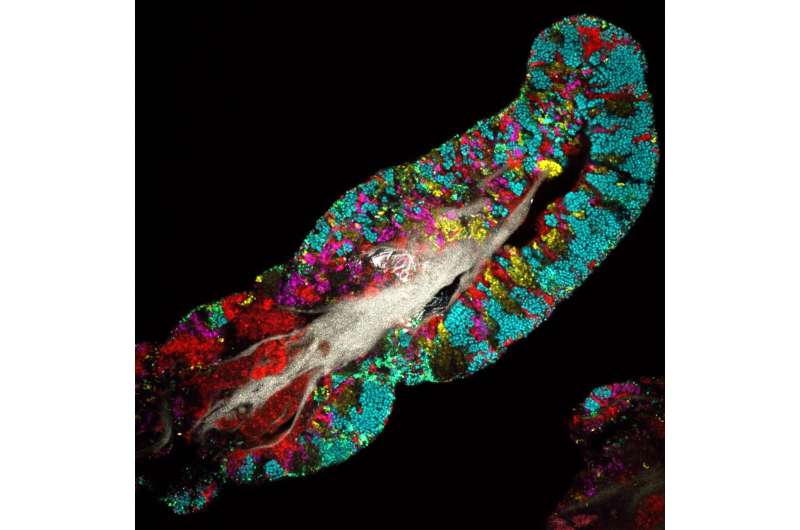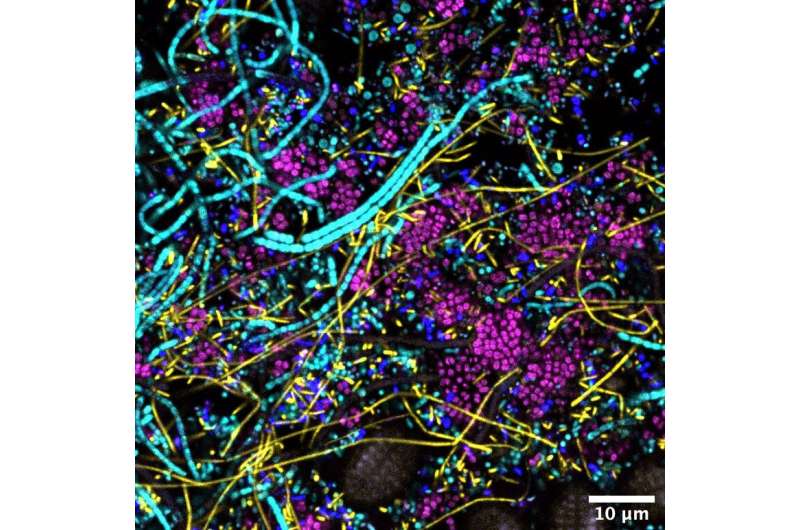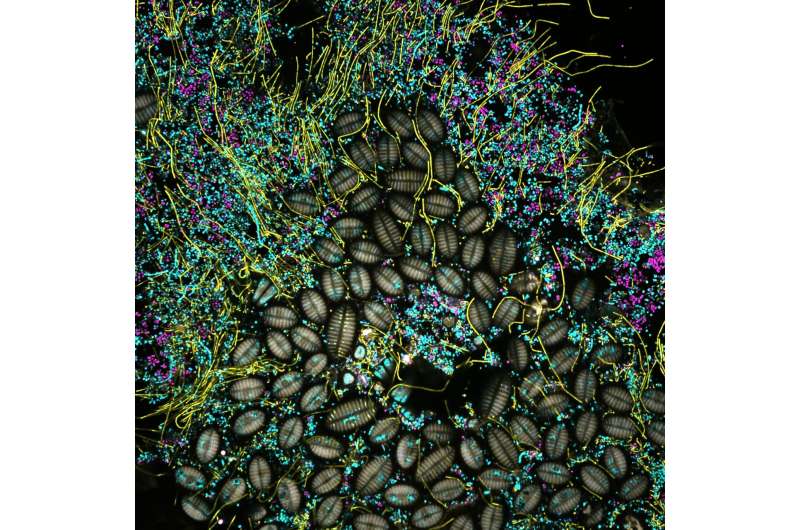As plant/animal diversity wanes, is microbial life changing too? A perilously 'profound ignorance'

Alarms about the declining diversity of plants and animals raise a related concern with equally profound implications: Is the variety of microbial life, including viruses, changing too? And if so, in which direction and how fast?
In a paper published today, David S. Thaler of the University of Basel, Switzerland, and guest investigator at Rockefeller University's Program for the Human Environment (PHE), notes the well-documented, "clearly downward" trajectory of plant and animal diversity, constituting "a key issue of the Anthropocene."
Whether change is underway also in the world of microbes—the tiniest cogs in planetary functioning—is "a complete unknown. We have no idea whether global microbial diversity is increasing, decreasing, or staying the same," says Dr. Thaler.
"Most scientific papers tell us new facts. This is a different kind of paper; it does not answer anything but asks a new question," says Dr. Thaler.
"Socrates called ignorance of what we do not know 'profound ignorance." This kind of ignorance was also famously termed 'unknown unknowns' by former U.S. Defense Secretary Donald Rumsfeld. Today's paper identifies what is (or was, as of now) a biological 'unknown unknown.'"
Dr. Thaler points out that assessing plant and animal biodiversity involves counting different species within a given timeframe, and then comparing a subsequent count. By doing so, we learned that some species have recently become extinct, and many exist in fewer numbers, with an estimated one million at risk of extinction within decades.
The same approach has been used, for example, to monitor changes in intestinal microbial diversity due to dietary changes.
Unfortunately, says Dr. Thaler, it may be impossible to "count everything at different times" to figure out the direction of change in global microbial biodiversity because:
- The extent of current microbial biodiversity is unknown, and a large fraction of the microbial world may exist in hard-to-access, rare or extreme environments—the deeper the depth, the less we know. Previous research has theorized that the deep hot biosphere may contain the majority of our planet's microbial biodiversity. Resolving this problem might require 20 years before there is a sufficient understanding of the deep biosphere and other hard-to-access environments.
- A possible 'chicken and egg' paradox may prove hard to resolve: Establishing a baseline sequence library may never be finished because new diversity is generated more rapidly than it is measured. If some or all parts of microbial diversity are rapidly increasing, then survey approaches may never catch up to this dynamic process.
Dr. Thaler says that the world is finding hundreds of variants of the SARS-CoV-2 virus that causes COVID-19, one of a roughly estimated 10 billion kinds of microbes, each evolving in its own ways.

Dr. Thaler cites a Harvard Medical School video documenting how quickly bacteria can mutate to overcome increasing higher concentrations of antibiotics. Meanwhile, a recent study also estimates that there are more than 1 million animal viruses, about half of them potentially infectious to humans.
"Microbial evolution is not always toward greater diversity; microbes can also become extinct, smallpox virus being an example," he adds. "Countless other viruses and bacteria probably have also come and gone without our ever having known of their existence. Some microbes are specific in their associations with certain animals and plants. As these plants and animals become extinct, it seems likely that specialized microbes associated with them have also vanished."
"The key point is that with plants and animals, we know that the current overall trajectory of Earth's biosphere is toward fewer species, but there is no comparable understanding of the overall trajectory or detailed fine-structure trajectories of microbial evolution."
Possible implications in the trajectory of microbial evolution are not limited to the evolution of pathogens that attack humans or the few species we depend on for our food.
Changes in non-pathogenic microbial life might also have major implications for the biosphere. The importance of these complex communities of microorganisms—with estimates of up to 10 billion types of microbes alone—is hard to overstate: They maintain Earth's habitability.
In 2011, scientists estimated that Earth's plant and animal species (or "macrobes") numbered almost 10 million, meaning therefore that for every "macrobe" species, there are 1,000 kinds of microbes, with the same macrobe/microbe ratio applicable to both terrestrial and marine species.
Humanity depends on the ecological services performed by bacteria, archaea, fungi and protists, which recycle nutrients, nurture plant growth, purify water, make cheese and wine, and decompose wastes. And by turning atmospheric carbon dioxide back into carbon to be stored in soils or the ocean depths (and doing likewise with nitrogen, sulfur, iron, manganese and more), microbes are key to Earth's atmosphere and climate.
Globally today, heritable DNA sequence information "is probably dominated by microbes, including viruses," Dr. Thaler says. "The intriguing possibility is that macroscopically visible animals and plants may constitute an ever-shrinking proportion of the biosphere's heritable information. We really don't know."
"We probably ought to know if we are on the losing end of a biological information race, however, and might even want to take practical steps to increase the information content of 'our team." There is also a purely intellectual interest to learn more about our place in the universe of biological information, perhaps analogous to our place in an expanding physical universe."
This is a hard question, but hard does not mean impossible. He adds, "What approaches at least begin to address it?"

DNA technologies are an obvious place to look. How might current technologies be applied and how might future developments help? Two approaches suggest themselves, says Dr. Thaler.
One is to focus on "modulators and vectors" of microbial evolution such as bacterial sex. Other new approaches that might be harnessed include single molecule or single cell (DNA) sequencing.
DNA barcodes and other sequence-based methods used to identify species of plants and animals and to assess the amount of variation within species "invite comparison to measures of microbial biodiversity," Dr. Thaler says.
"The clustering pattern seen in macroscopic life seems in a general way also a property of microscopic forms of life. The details of comparison are of interest. There might be quantitative general principles behind the truism that 'life is lumpy.'"
In both the microbial and the macroscopic world of visible plants and animals, a species may be considered a cluster "in sequence space," which can be thought of in terms of stars and galaxies, where individuals are stars and species are galaxies.
Jesse Ausubel, director of the Rockefeller University's PHE, a sponsor of the study, says, "Linnaeus started his Systema Naturae in 1735, almost 300 years ago, and we still do not have a complete list of the species of plants and animals that he started to catalog. It will not be easy to do something similar with probably 1,000 times as many microbes, and measure the changes!"
Visual images from the laboratories of Gary Borisy (Forsyth Institute) and Jessica Mark Welch (Marine Biological Laboratory) show the difficulty of direct counts. A few tens of micrometers, the width of a human hair, span entire diverse, populous communities of microbes.
Dr. Thaler says this paper does not offer "protocols to solve the problem," but tries "to frame the rate of change of microbial biodiversity as an interesting and possibly important question on which progress is possible. I hope that someone reading this paper is stimulated to think of new approaches better than the ones suggested in it."
Adds Mr. Ausubel: "There is no agency yet monitoring the state of the microbial world, and no World Wildlife Fund, no Nature Conservancy for microbes. Perhaps one day soon we will realize and rectify our neglect and lift our respect for the diversity of microbial life."
More information: David S. Thaler. Is Global Microbial Biodiversity Increasing, Decreasing, or Staying the Same?, Frontiers in Ecology and Evolution (2021). DOI: 10.3389/fevo.2021.565649
Journal information: Frontiers in Ecology and Evolution
Provided by Frontiers in Ecology and Evolution




















